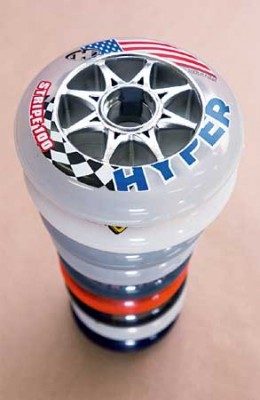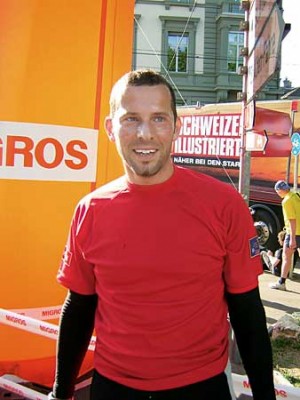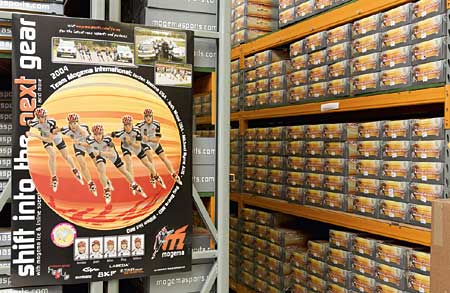
Leading the race
With Mogema speed-skating products, Dutch company Sportsinline International has a history of helping competitive inline skaters shave fractions of a second off their time.
Summary
Mogema speed skating products are designed, produced and distributed worldwide by Sportsinline International b.v. in the Netherlands.Frame design and manufacturing is a speciality and Mogema has been doing it since 1985. Together with top international athletes, Mogema is currently developing, researching and testing new concepts with a goal of supplying the very best gear.At the 2001 Roller World Cup, 36 medals were won on Mogema’s Dual Box™ frames, including 15 gold medals.
With Mogema speed-skating products, Dutch company Sportsinline International has a history of helping competitive inline skaters shave fractions of a second off their time.
Ever watched an inline skater testing a skate? The way he holds the skate upside down and spins the wheels, checking that the spin is fast and smooth?
If there is the smallest interference, the wheels are taken off and the bearings are cleaned. And if the first cleaning doesn’t do it, the process will be repeated until the skater is completely satisfied. Because everything comes down to hundredths of a second. Especially if you are competing among world-class inline speed skaters.
These skaters are looking for the best frame, bearing, shoe and wheel – equipment that can take the force of the push on the set surface with the least friction under all weather conditions.
“Often it’s all in their mind, but if the mind isn’t at rest, they won’t do well in the race,” says Diederik Hol, general manager for Dutch Sportsinline International BV, which designs and produces Mogema speed-skating products.
Sportsinline International was set up in 1999, but Mogema has specialized in frame designs since 1985. The Mogema metalworking group in Holland was the first to design and produce an inline skater frame, and its Diamond frame was for years the most used in the world.
In terms of staff, the company would be considered small. Only six people work at the offices in the Dutch town of ’t Harde, and five of them are devoted skaters, either on ice or on wheels. But Mogema has about 30 percent of the world speed-skating market for inline frames. Sales are largest in the Netherlands, Germany, Switzerland, Korea and North America.
Mogema products are designed for competitive skaters rather than the ordinary roller stroller, and they are only distributed through specialized skating shops.
“We don’t really produce anything for the recreational market,” says Maarten van der Ven, sales manager at Sportsinline. “A complete pair of our inlines, with shoe, frame, wheels and bearings, costs from 350 to 1,000 euros.
One of Sportsinline’s most important innovations was the development of the DualBox Frame (M55) in 2000. This new frame concept was built with tubes to create flexural and torsional stiffness.
The need for cross-bracing between the sides was eliminated, which made the frame lighter. Other benefits were less road vibration, less wear on the front wheel and less bend of the frame, which gave the rider better grip in the corners.
The cooperation with SKF began in 2001 when Mogema started to use SKF speed-skate bearings. Bearings and lubrication were selected and samples were made at the SKF product divisions in France and Italy. Positive test results led to the beginning of a fruitful partnership between SKF Industrial Division in the Netherlands and Mogema. In 2002 the two companies signed an agreement that made SKF the sole provider of bearings for Mogema speed skates. The agreement also covered distribution of SKF speed-skate bearings and lubricants for the after market as well as mutual sponsoring activities.
The companies have now entered a second phase in this partnership, working together to develop a whole new type of skate.
Higher speed and new challenges create new dynamic situations for the materials used. Racing conditions vary a lot. In addition surfaces can be very unpredictable, changing quickly with sharp bends and going from flat to hilly. The skater has to be able to move quickly within the pack and to be able to increase speed instantly when there is an opportunity. Stability is essential. And so are good bearings.
“One of the main issues for a skater is how you keep your bearings clean,” says Diederik Hol. “There is so much dirt near road surfaces, and dirt ruins the bearings. The wheel won’t spin the way you want. We were searching for a solution to adapt a new bearing that needs less maintenance – a bearing that doesn’t have to be disassembled.”
SKF came with a solution where bearings and spacer are supplied as one unit, which makes the bearings easier to mount, makes them more resistant to external strains and offers a longer lifespan.
But there are several manufacturers of wheels worldwide, all following the same standard, so changing the wheel moulds wasn’t an option. This new type of bearing had to fit the old system, with bearings parts coming separately.
“The bearings are one part of this new development,” Hol says. “The second part was the idea of a whole new frame setup where we have adjusted the frame to the new bearings. This should make a significantly better skate, with the biggest advantage being the new bearing unit in combination with a frame that’s both lighter and stiffer.”
The new frame is using the DualBox frame concept to create a monoframe. The tubular construction gives stability, and the fact that it is a single frame makes it easy to fit the new types on factory-set bearings.
To make sure the theory works in practice, new tests and calculations were made on the DualBox frame. These FEM (final element) calculations and tests were made by the SKF Engineering Consultancy Services at SKF’s Business and Technology Park, in Dutch Nieuwegein, south of Utrecht.
“These results were very important to us,” says Hol. “We wanted to be sure we could reach our goal before we spent money on moulds and prototypes.” The new skate is scheduled to enter the market in 2005.
The Netherlands has a unique position in the specialized skating market, mainly due to the traditional widespread interest in ice skating, which is about 20 percent of Sportsinline’s business.
The Dutch infrastructure also has a huge impact on the popularity of inline skating.
“In other countries you have to practise on special tracks and rinks,” Hol explains. “We are a flat country full of bicycle lanes, which means you can practise at your doorstep.”
There are about 50 specialized skating shops in the country. “In comparison,” says Maarten van der Ven, “in other countries you might find four or five.”
The crossover between inlines and ice skating is growing. Many competitive ice skaters do inlines to get more exercise. And competitive inline skaters go ice skating because there is more money to be made on the ice. Others go for ice skating because it is the only way to get an Olympic medal. There are many who hope that inline speed-skating will be an Olympic event in 2008.
Sportsinline sponsors three inline teams: Team Mogema International, with one Australian, two American and two Dutch skaters; the Mogema National German team; and Mogema Labeda National Team in the United States.
“Five percent of our turnover goes to sponsoring,” says van der Ven. “We also are material sponsors of the Rollerblade World Team and of several local clubs.”
The partnership with Sportsinline includes sponsoring the teams with money and material, so the SKF logo is seen on Mogema suits during competitions.
Team Mogema International is the Dutch-based team, even though it has an international make-up. The team members spend several months a year of training in Oldebroek, situated a couple of minutes away from Sportsinline’s office in ’t Harde.
“This area is full of training opportunities,” says van der Ven. “Close by is the inline skating track in Heerde, host for the European Speed Skating Championships in August 2004.
Inline skating is a trend-sensitive market, where everyone is looking to the newest developments to gain more speed. During the years it has been proven that size matters. In the 1980s inline wheels were 76 millimetres, but during the 1990s 84 millimetres became the standard. In 2003 100-millimetre wheels started being used.
“These put more pressure on the bearings and on the frame itself, but the top speed is higher,” says van der Ven. “The challenge is to make sure the frame remains as low as possible. The lower the frame, the better the stability.”
Using bigger wheels, he says, is much like starting a car in a high gear. “The acceleration is slow, but when you get the speed it’s higher, which makes the wheels good for long distances.”
The big question now is which wheels the racers of tomorrow will use. Should the new tubular monoframe be developed for 84-millimetre wheels or 100-millimetre wheels? This question elicits a smile from Diederik Hol. “We’ll have to wait and see,” he says.
No compromises
“No Compromises” is the name of the SKF product range adapted for the different disciplines in skating and skate boarding.
What bearing to use depends on the conditions and if the skating is for competition or recreation and takes place inside or outside. The added value of this range is its flexibility and the possibility for upgrades and adjustments to every discipline and circumstance, such as surface and weather conditions.
- Lubrication:Oil for speed, as oil gives the lowest friction. Grease for recreational bearings, as grease keeps off dirt and dust, which means less maintenance. Grease lubrication also protects against humidity and rust.
- Seals:Metal shields or, alternatively, the other SKF solution, the non-contact two-lip design, which gives twice as effective protection against dirt as the standard metal seal.
- Cages:Steel or polyamide. The SKF polyamide solution is shock resistant and provides better ball guidance with less friction.
- Raceway precision: The inner finish of the bearing is the key to quality and optimization, including surface treatment and accuracy of tolerance.








